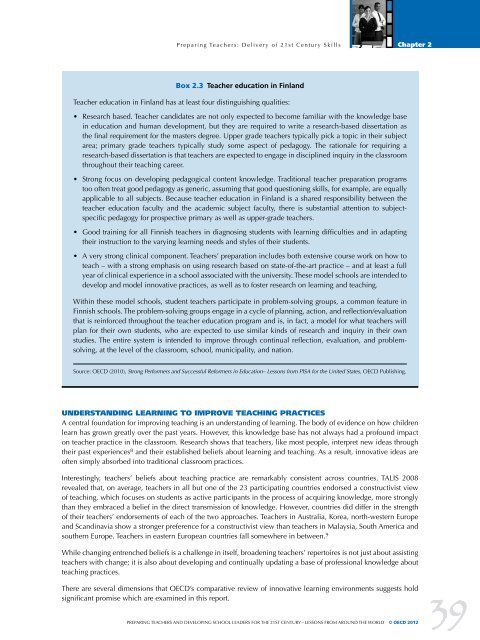Preparing Teachers and Developing School Leaders for the 21st Century
Preparing Teachers and Developing School Leaders for the 21st Century
Preparing Teachers and Developing School Leaders for the 21st Century
You also want an ePaper? Increase the reach of your titles
YUMPU automatically turns print PDFs into web optimized ePapers that Google loves.
<strong>Preparing</strong> teachers: delivery of <strong>21st</strong> century skills<br />
Box 2.3 Teacher education in Finl<strong>and</strong><br />
teacher education in finl<strong>and</strong> has at least four distinguishing qualities:<br />
• research based. teacher c<strong>and</strong>idates are not only expected to become familiar with <strong>the</strong> knowledge base<br />
in education <strong>and</strong> human development, but <strong>the</strong>y are required to write a research-based dissertation as<br />
<strong>the</strong> final requirement <strong>for</strong> <strong>the</strong> masters degree. upper grade teachers typically pick a topic in <strong>the</strong>ir subject<br />
area; primary grade teachers typically study some aspect of pedagogy. <strong>the</strong> rationale <strong>for</strong> requiring a<br />
research-based dissertation is that teachers are expected to engage in disciplined inquiry in <strong>the</strong> classroom<br />
throughout <strong>the</strong>ir teaching career.<br />
• strong focus on developing pedagogical content knowledge. traditional teacher preparation programs<br />
too often treat good pedagogy as generic, assuming that good questioning skills, <strong>for</strong> example, are equally<br />
applicable to all subjects. Because teacher education in finl<strong>and</strong> is a shared responsibility between <strong>the</strong><br />
teacher education faculty <strong>and</strong> <strong>the</strong> academic subject faculty, <strong>the</strong>re is substantial attention to subjectspecific<br />
pedagogy <strong>for</strong> prospective primary as well as upper-grade teachers.<br />
• good training <strong>for</strong> all finnish teachers in diagnosing students with learning difficulties <strong>and</strong> in adapting<br />
<strong>the</strong>ir instruction to <strong>the</strong> varying learning needs <strong>and</strong> styles of <strong>the</strong>ir students.<br />
• A very strong clinical component. <strong>Teachers</strong>’ preparation includes both extensive course work on how to<br />
teach – with a strong emphasis on using research based on state-of-<strong>the</strong>-art practice – <strong>and</strong> at least a full<br />
year of clinical experience in a school associated with <strong>the</strong> university. <strong>the</strong>se model schools are intended to<br />
develop <strong>and</strong> model innovative practices, as well as to foster research on learning <strong>and</strong> teaching.<br />
Within <strong>the</strong>se model schools, student teachers participate in problem-solving groups, a common feature in<br />
finnish schools. <strong>the</strong> problem-solving groups engage in a cycle of planning, action, <strong>and</strong> reflection/evaluation<br />
that is rein<strong>for</strong>ced throughout <strong>the</strong> teacher education program <strong>and</strong> is, in fact, a model <strong>for</strong> what teachers will<br />
plan <strong>for</strong> <strong>the</strong>ir own students, who are expected to use similar kinds of research <strong>and</strong> inquiry in <strong>the</strong>ir own<br />
studies. <strong>the</strong> entire system is intended to improve through continual reflection, evaluation, <strong>and</strong> problemsolving,<br />
at <strong>the</strong> level of <strong>the</strong> classroom, school, municipality, <strong>and</strong> nation.<br />
source: oecd (2010), Strong Per<strong>for</strong>mers <strong>and</strong> Successful Re<strong>for</strong>mers in Education– Lessons from PISA <strong>for</strong> <strong>the</strong> United States, oecd Publishing.<br />
Chapter 2<br />
undersTAndIng leArnIng To Improve TeAChIng prACTICes<br />
a central foundation <strong>for</strong> improving teaching is an underst<strong>and</strong>ing of learning. <strong>the</strong> body of evidence on how children<br />
learn has grown greatly over <strong>the</strong> past years. however, this knowledge base has not always had a profound impact<br />
on teacher practice in <strong>the</strong> classroom. research shows that teachers, like most people, interpret new ideas through<br />
<strong>the</strong>ir past experiences 8 <strong>and</strong> <strong>the</strong>ir established beliefs about learning <strong>and</strong> teaching. as a result, innovative ideas are<br />
often simply absorbed into traditional classroom practices.<br />
Interestingly, teachers’ beliefs about teaching practice are remarkably consistent across countries. TALIS 2008<br />
revealed that, on average, teachers in all but one of <strong>the</strong> 23 participating countries endorsed a constructivist view<br />
of teaching, which focuses on students as active participants in <strong>the</strong> process of acquiring knowledge, more strongly<br />
than <strong>the</strong>y embraced a belief in <strong>the</strong> direct transmission of knowledge. however, countries did differ in <strong>the</strong> strength<br />
of <strong>the</strong>ir teachers’ endorsements of each of <strong>the</strong> two approaches. <strong>Teachers</strong> in Australia, Korea, north-western Europe<br />
<strong>and</strong> sc<strong>and</strong>inavia show a stronger preference <strong>for</strong> a constructivist view than teachers in Malaysia, south america <strong>and</strong><br />
sou<strong>the</strong>rn europe. teachers in eastern european countries fall somewhere in between. 9<br />
While changing entrenched beliefs is a challenge in itself, broadening teachers’ repertoires is not just about assisting<br />
teachers with change; it is also about developing <strong>and</strong> continually updating a base of professional knowledge about<br />
teaching practices.<br />
There are several dimensions that OECD’s comparative review of innovative learning environments suggests hold<br />
significant promise which are examined in this report.<br />
PreParing teachers <strong>and</strong> develoPing school leaders <strong>for</strong> <strong>the</strong> <strong>21st</strong> century – lessons froM around <strong>the</strong> World © OECD 2012<br />
39


